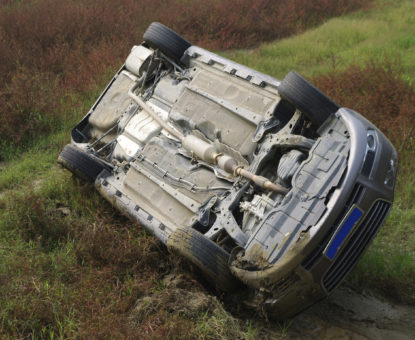7 defensive driving tips everyone should know

Car overturned
Think a car crash can’t happen to you? Think again. According to the National Highway Traffic Safety Administration, there were an estimated 9.8 million police-reported traffic crashes in 2012. About 45,500 were fatal, and another 2.09 million people were injured.
There are a few no-brainer rules of the road that every driver should follow to protect herself and everyone else on the road: buckle up, don’t text while driving and never drive under the influence of alcohol or narcotics.
However, since more than 90 percent of car accidents are due to driver error, we could all use a refresher course on how improve our driving skills. Here are the best tips for how to be a smarter and safer when you’re behind the wheel.
1. Raise your gaze
Most people tend to stare at the bumper of the car in front of them when driving, but what you should be doing is looking five or six cars ahead of you.
Your eyes should always be moving. Look ahead, then switch between each of your car’s rearview mirrors every three to five seconds, says Solomon.
2. Remember the three-second rule
Always be prepared for the car in front of you to stop, slow down or hit unexpected road debris. You probably learned the three-second rule in Driver’s Ed, which is a simple way to ensure you’re driving at a safe following distance during good road conditions. You pick a fixed point that’s even with the car in front of you, like a road sign, and start counting. If you reach that spot before your hit three, you’re driving too close to the car in front of you.
When road conditions are bad — it’s raining, foggy, or icy, for instance — you’ll want to build in even more time for a sudden stop or skid, says Solomon. He calls it the “three-second plus formula” and recommends adding an extra second for each driving condition. So if the roads are icy, leave four seconds between you and the next car. If the roads are icy and it’s snowing, leave five seconds.
3. Avoid target fixation
If an accident seems imminent, don’t focus on the obstacle you are trying to avoid colliding with, says McGovern. (You’re more likely to do this when you’re tired, on your cell phone or under the influence of alcohol.) Focus instead on your escape route.
“Almost anything is better than the impact of a collision,” says Solomon. “If you must hit something, hit something that doesn’t endanger human life — an object that you know you can push over or push down as you slow, such as safety cones. Avoid ‘sudden stop items,’ such as tree or utility poles, at all costs.”
Remember the four Rs: Read the road ahead, reduce your speed, drive to the right, and ride off of the road.
4. Steer into a slide
A great way to help you remember the rule that you should always turn into a slide: A car always turns better than it stops. If you find your car sliding, with your foot off the brake, go in the direction of the skid or slide. Then steer the wheel to avoid any obstacles. Once out of harm’s way, use a little bit of power on the gas pedal and steer the wheel back into a straight position.
5. Keep your hands at 10 and 2 o’clock when you turn
When turning the car, many drivers put their right or left hand on the inside of the wheel to get leverage. However, doing that can be dangerous. If you’re in an accident and the airbag engages, “the force of the explosion would push your fists into your face at about 100 mph,” says Solomon.
6. Check your tire pressure and tread
Blowouts on the road can be terrifying and even deadly. You should monitor your tire pressure two to three times per month. When your tire pressure is at its optimum level, you’re better able to safely drive around obstacles because the car will perform the way you want it to.
To check your tire pressure, pick up a tire gauge at a hardware store and ask a service station attendant to show you how to use it. Your vehicle manual will tell you where on your car you’ll find the recommended pound per square inch (psi) for your tires. Many newer cars come with optional tire pressure monitors right on the dashboard.
You also want to check your tire tread. “Most tires have a wear bar between the tread,” says McGovern. “It looks like a rubber bridge from one tread pattern to another.” When the rubber gets to that point, you need to look for new tires.
You need at least 50 percent tread to channel water or snow between the tire and asphalt. The less tread you have, the less grip you have on the road. If you don’t have a wear bar on your tires, pick up a tread gauge at an auto parts store.
7. Take driving seriously
The act of driving deserves 100 percent of your focus. If you’re glancing down to read a text, fishing around in your bag for pen or turning around to yell at your kids, you’re not being a responsible driver.
“If you end up in a situation where someone was seriously injured or died in an accident you were involved in, you’d realize that reading that text about picking up milk should have waited,” says McGovern.
Source: Safebee
